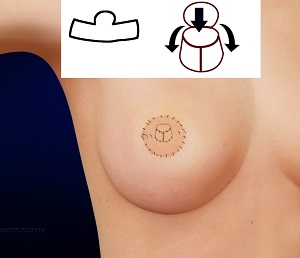
What is Nipple Reconstruction?
Nipple reconstruction is a surgical procedure that involves reconstructing a new nipple and areola using surrounding healthy skin tissue after your breast has healed from a mastectomy (surgical removal of the breast) or breast reconstruction. The procedure involves making a star-shaped incision to form a new nipple and then adding a tattoo to shade in the new areola.
Types of Nipple Reconstruction
There are many methods to reconstruct your nipple. Your surgeon will decide on the best possible method based on the condition of your breast. Some of these methods include:
- Skin Flap Reconstruction: In this method, small skin flaps from your reconstructed breast are folded and stitched together to construct a mound that forms your new nipple. The skin is shaped to accord the nipple an upraised look in comparison to the breast mound. Extra fat, skin, or synthetic fillers may be used to give the nipple a more elevated look.
- Skin Graft Reconstruction: In this method, a small slice of skin is taken from another part of the body, such as the buttocks, thigh, or stomach to make a nipple when sufficient skin is not available in the new breast.
- Nipple Sharing/Autologous Graft: In this method, a section of the nipple from your unaffected breast is taken and grafted into your new breast to form a new nipple. This is only done if your surgeon deems the nipple from the unaffected breast is large enough to be extracted and grafted.
- Medical Tattooing: An individual may choose to get medical tattooing done after a nipple is reconstructed to achieve a natural-looking nipple and areola. Women who are averse to undergo additional surgery for nipple reconstruction may opt to have only medical tattooing; however, it is important to know that the nipple is not elevated in this situation.
Preparation for Nipple Reconstruction
In general, preparation for nipple reconstruction may involve the following:
- A thorough examination by your doctor is performed to check for any medical issues that need to be addressed prior to the procedure.
- Depending on your medical history, social history, and age, you may need to undergo tests such as blood work and a mammogram to help detect any abnormalities that could threaten the safety of the procedure.
- You will be asked if you have allergies to medications, anaesthesia, or latex.
- Inform your doctor of any medications, vitamins, or supplements that you are taking.
- Refrain from taking any anti-inflammatory drugs, aspirin, or supplements, as they may increase the chance of bleeding.
- You should not consume any solids or liquids at least 8 hours prior to surgery.
- You may be instructed to shower with an antibacterial soap the night prior to surgery.
- Refrain from using lotions or deodorants after a shower.
- Wear comfortable and loose-fitting clothes on the day of surgery.
- Refrain from smoking pre- and post-procedure for a specific period of time, as this may hamper proper healing and increase your chances of areolar or nipple damage, tissue necrosis, and other complications.
- A written consent will be obtained from you after the procedure has been explained in detail.
Postoperative Care and Recovery
Most people can go home the same day of surgery if no complications are noted. In general, postoperative care instructions and recovery may involve the following:
- You may experience some sensitivity, tenderness, or swelling in your nipple. Pain and anti-inflammatory medications are provided as needed.
- Your physician will also provide you with antibacterial ointment to prevent the risk of nipple infection while healing.
- A nipple shield is provided to be used for 3 days to protect the nipple from any rubbing or any harm.
- A surgical or sports bra is provided to hold the surgical dressing in place and protect the nipple.
- Use of gauze or cotton inside your bra is recommended to cushion your new nipple while it is healing.
- Your doctor will provide you with instructions on bathing and wound care.
- Refrain from using soaps containing harsh chemicals that may irritate your nipple.
- Refrain from any strenuous activities such as aerobics and jogging for at least a week to allow your nipple to heal completely. However, you may resume your normal household activities within a couple of days.
- A periodic follow-up appointment will be scheduled to monitor your overall progress.
Risks and Complications of Nipple Reconstruction
Nipple reconstruction is a relatively safe procedure; however, as with any surgery, the following risks and complications may occur:
- Pain
- Bleeding
- Swelling
- Infection
- Nipple retraction or flattening
- Loss of nipple sensation
- Tissue breakdown or necrosis (tissue death)
- Tissue rejection
- Changes in nipple appearance
